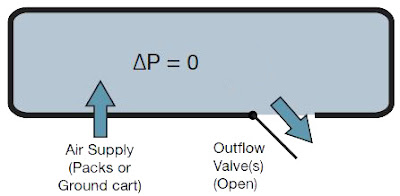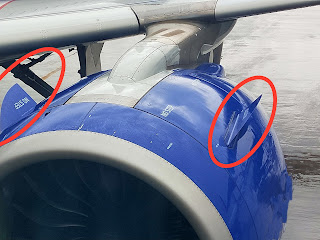Aircraft Cabin Differential Pressure Warning
Commercial aircraft usually fly at high altitude to get advantage of fuel economy and calm weather. As the aircraft climb, the atmospheric pressure falls with increase in altitude. The low pressure at high altitude is created the unsafe environment for passengers and crews. Aircraft operating at high cruising altitude is typically equipped with pressurized cabin to protect the aircraft occupant against low atmospheric pressure. Aircraft cabin pressurized with constant pressure is usually maintained 8000 ft cabin altitude.
The cabin internal pressure is regulated by automatic cabin pressure control system. Cabin pressure also regulated by flight crew through manual control if automatic cabin pressure control system failed. When cabin pressure is lower than atmospheric pressure negative pressure differential condition developed which is dangerous for aircraft structure. Positive pressure condition is developed when cabin pressure is greater than atmospheric pressure which is hazardous situation for the person who is opening the door.
If aircraft parked on ground after a flight, the cabin pressure should return to atmospheric pressure to ensure zero differential pressure between cabin interior and outside atmosphere. Zero differential pressure ensure safe door opening.
In existing cabin differential condition, when aircraft door unlocked and opened, the quick uncontrollably strong airflow created which is correspond to suction effect, this suction effect cause rapid door opening movement. This leads to a considerable risk to those persons who operate the door or are in their immediate vicinity. In addition, structural damage to aircraft may occur.
In order to ensure safety of person and to alert the person about cabin pressurization, aircraft having pressurized cabin are equipped with a cabin differential pressure warning system. When an intentional opening of door detects any cabin differential pressure then warning signal will generate to alert for the person who is opening the door.
Cabin differential pressure warning system alert the person before opening of door so accordingly appropriate action taken to ensure pressure balance between cabin and outside environment., so that opening of door carried out safely.
Cabin differential warning system usually an electrical driven optical warning mechanism consisting of red lamp in the window area of door which begin to blink in connection with existing differential pressure. In case of emergency evacuation of aircraft, in which all the occupant must have exited from the aircraft within 90 seconds , untrained person such as passenger would crease or abstain from the operation of door due to blinking of door warning lamp. As a consequence evacuation would be delayed. To avoid evacuation delay in emergency condition, the emergency evacuation signal provided to cabin differential pressure warning system to which deactivate warning.
The activation signal for cabin differential pressure warning system, varies from aircraft to aircraft. Normally pressure warning system uses the differential pressure, engine on/off ,door escape slide armed/disarmed and emergency evacuation activation signal.
Fig 04 Vent Door For Equalizing the air pressure
Aircraft cargo door which doesn't have residual pressure warning system usually equipped with vent door which equalize the air pressure between the cargo compartment and outside environment when operator opens the cargo door.
To watch the video of this blog please click on below link
Please Follow and Join us on below aircraft technical group there you can share your doubt.
Telegram
https://t.me/joinchat/NxLqTH2cTX9hMjM1
https://www.facebook.com/groups/304288677920172/?ref=share
https://www.instagram.com/invites/contact/?i=1tv1l3w2dcogj&utm_content=m7ttk5x
YouTube Channel
https://www.youtube.com/channel/UCwfz-cO2H3k8tnA_CMrMKtw







Comments
Post a Comment